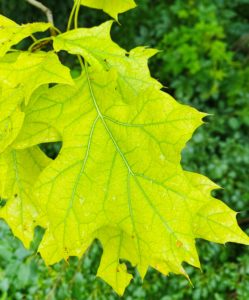Mike Hillstrom, forest health specialist, Fitchburg, Michael.Hillstrom@wisconsin.gov, 608-513-7690
Chlorosis, which is marked by yellow leaves with green veins, is a common tree and shrub issue in Wisconsin. It is often a result of a nutrient deficiency of iron and manganese.

A chlorotic oak leaf displays yellow leaf tissue with green veins.
Typically, iron and manganese are present in the soil, but they can become unavailable to tree roots if the soil’s pH is too high. A soil pH of 5.5 to 6.5 is optimal for nutrient uptake for most trees, although some conifers prefer 5.0 to 6.0. Excessive amounts of potassium, magnesium and phosphorus may also contribute to chlorosis. More rarely, soil fertility is poor and chlorosis can be caused by insufficient nutrient levels in the soil.
Although many species can be impacted by chlorosis, oaks have been the main source of concern for landowners recently. The damage is often temporary, and the tree(s) recovers, but in severe cases, mortality of branches or entire trees can occur. More often though, mortality is likely to be caused by other health issues, in some cases in combination with chlorosis. Other issues impacting oaks include oak wilt, bur oak blight, frost damage, tatters, two-lined chestnut borer, armillaria and fungal leaf pathogens.
The first step to dealing with chlorosis is to get soil and foliage nutrients tested through the UW Soil and Forage Lab. Determining the pH and nutrient levels in your soil is critical before selecting a treatment. Soil amendments commonly used to treat chlorosis include chelated iron and sulfur. Time and cost constraints are likely to limit soil amendment treatments to yard trees or trees located along the edges of forests where they are regularly seen by landowners.
For more information, see the UW-Madison Extension chlorosis factsheet.
